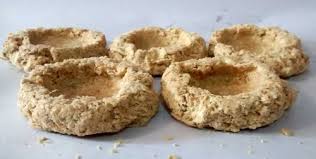
Sesame is a flowering plant in the genus Sesamum, also called benne. Numerous wild relatives occur in Africa and a smaller number in India. It is widely naturalized in tropical regions around the world and is cultivated for its edible seeds, which grow in pods. World production in 2018 was 6 million tonnes, with Sudan, Myanmar, and India as the largest producers.

Sesamum is a leguminous crop and genus of about 20 species in the flowering plant family Pedaliaceae. The plants are annual or perennial herbs with edible seeds. The best-known member of the genus is sesame, Sesamum indicum, the source of sesame seeds. The species are primarily African, with some species occurring in India, Sri Lanka, and China. The origin of S. indicum is uncertain, as it is widely cultivated and naturalized in tropical regions. The genus is closely related to the strictly African genus Ceratotheca and is itself probably African in origin.

Pedaliaceae, the pedalium family or sesame family, is a flowering plant family classified in the order Lamiales. The family includes sesame, the source of sesame seeds.

Tilkut also known as tilkutam, gajak, tilpatti, is a sweet made in the Indian states of Bihar, Jharkhand, West Bengal and Madhya Pradesh.

Psilogramma increta, the plain grey hawkmoth, is a moth of the family Sphingidae.
Pseudomonas amygdali is a Gram-negative plant pathogenic bacterium. It is named after its ability to cause disease on almond trees. Different analyses, including 16S rRNA analysis, DNA-DNA hybridization, and MLST clearly placed P. amygdali in the P. syringae group together with the species Pseudomonas ficuserectae and Pseudomonas meliae, and 27 pathovars of Pseudomonas syringae/Pseudomonas savastanoi, constituting a single, well-defined phylogenetic group which should be considered as a single species. This phylogenetic group has not been formally named because of the lack of reliable means to differentiate it phenotipically from closely related species, and it is currently known as either genomospecies 2 or phylogroup 3. When it is formally named, the correct name for this new species should be Pseudomonas amygdali, which takes precedence over all the other names of taxa from this group, including Pseudomonas savastanoi, which is and inadequate and confusing name whose use is not recommended.
In enzymology, a sucrose 6F-alpha-galactosyltransferase is an enzyme that catalyzes the chemical reaction

Hippotion echeclus, the black-based striated hawkmoth, is a moth of the family Sphingidae. *

Wogonin is an O-methylated flavone, a flavonoid-like chemical compound which is found in Scutellaria baicalensis.

Oroxylum indicum is a species of flowering plant belonging to the monotypic genus Oroxylum and the family Bignoniaceae, and is commonly called Indian trumpet tree, oroxylum, Indian trumpet flower, broken bones, Indian caper, scythe tree or tree of Damocles. It can reach a height of 18 metres (59 ft). Various segments of the tree are used in traditional medicine, where it is known as Shyonaka or Sona Patha.

Oroxindin is a flavone, a type of phenolic chemical compound. It is a wogonoside, more accurately a wogonin glucuronide isolated from Oroxylum indicum (Bignoniaceae), Bacopa monnieri (Plantaginaceae) and Holmskioldia sanguinea.

Helicoverpa fletcheri is a species of moth of the family Noctuidae that is found in Africa, including Sudan.

Pinoresinol is a tetrahydrofuran lignan found in Styrax sp., Forsythia suspensa, and in Forsythia koreana. It is also found in the caterpillar of the cabbage butterfly, Pieris rapae where it serves as a defence against ants.

Coenotes eremophilae is a species of moth of the family Sphingidae first described by Thomas Pennington Lucas in 1891. It is known from Queensland, Western Australia and the Northern Territory.

Cornifrons ulceratalis is a species of moth in the family Crambidae. It is found in Portugal, Spain, Italy, Croatia, Bosnia and Herzegovina, Albania, Greece, Morocco, Algeria and the Canary Islands.

Sesamum radiatum is a species of flowering plant in the Pedaliaceae. It is in the same genus as sesame. It is known by the English common names benniseed, black benniseed, black sesame, and vegetable sesame. It is native to west and central Africa, has been cultivated since ancient times in Africa, and is sometimes also used in tropical Asia where it has become naturalized to a small extent.
Pandoraea thiooxydans is a Gram-negative, oxidase-positive, catalase-negative, aerobic, thiosulfate-oxidizing, rod-shaped, motile bacterium with a single polar flagellum, of the genus Pandoraea, isolated from rhizosphere soils of sesame in Junghwa-dong in the Republic of Korea.
Sphingobium indicum is a hexachlorocyclohexane-degrading bacteria with type strain MTCC 6364T. Its genome has been sequenced.

Sesamum alatum is a species of flowering plant in the Pedaliaceae. It is in the same genus as sesame. In English it is called winged-seed sesame. Its native range spans from Western Sahara to Egypt and south to KwaZulu-Natal in South Africa.













